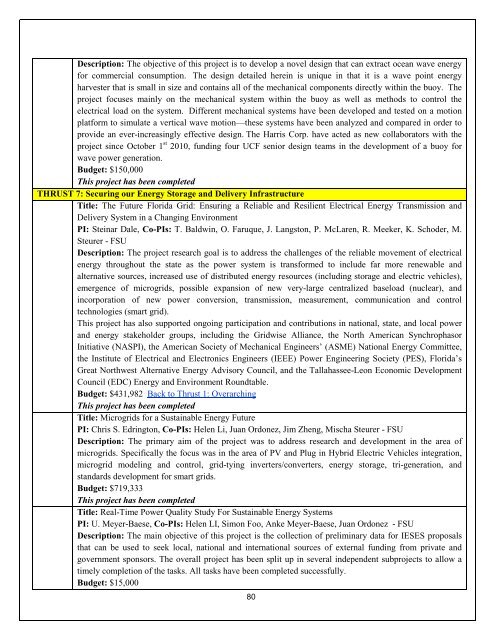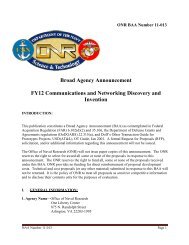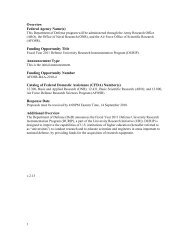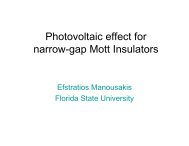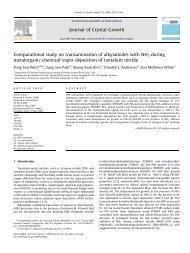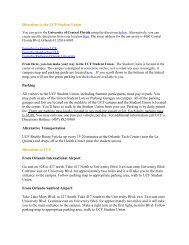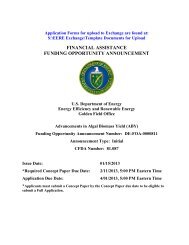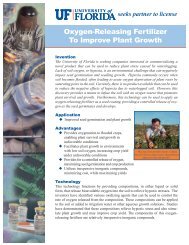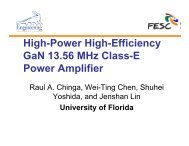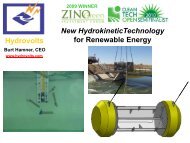Annual Report- Part III - Florida Energy Systems Consortium
Annual Report- Part III - Florida Energy Systems Consortium
Annual Report- Part III - Florida Energy Systems Consortium
You also want an ePaper? Increase the reach of your titles
YUMPU automatically turns print PDFs into web optimized ePapers that Google loves.
Description: The objective of this project is to develop a novel design that can extract ocean wave energyfor commercial consumption. The design detailed herein is unique in that it is a wave point energyharvester that is small in size and contains all of the mechanical components directly within the buoy. Theproject focuses mainly on the mechanical system within the buoy as well as methods to control theelectrical load on the system. Different mechanical systems have been developed and tested on a motionplatform to simulate a vertical wave motion—these systems have been analyzed and compared in order toprovide an ever-increasingly effective design. The Harris Corp. have acted as new collaborators with theproject since October 1 st 2010, funding four UCF senior design teams in the development of a buoy forwave power generation.Budget: $150,000This project has been completedTHRUST 7: Securing our <strong>Energy</strong> Storage and Delivery InfrastructureTitle: The Future <strong>Florida</strong> Grid: Ensuring a Reliable and Resilient Electrical <strong>Energy</strong> Transmission andDelivery System in a Changing EnvironmentPI: Steinar Dale, Co-PIs: T. Baldwin, O. Faruque, J. Langston, P. McLaren, R. Meeker, K. Schoder, M.Steurer - FSUDescription: The project research goal is to address the challenges of the reliable movement of electricalenergy throughout the state as the power system is transformed to include far more renewable andalternative sources, increased use of distributed energy resources (including storage and electric vehicles),emergence of microgrids, possible expansion of new very-large centralized baseload (nuclear), andincorporation of new power conversion, transmission, measurement, communication and controltechnologies (smart grid).This project has also supported ongoing participation and contributions in national, state, and local powerand energy stakeholder groups, including the Gridwise Alliance, the North American SynchrophasorInitiative (NASPI), the American Society of Mechanical Engineers’ (ASME) National <strong>Energy</strong> Committee,the Institute of Electrical and Electronics Engineers (IEEE) Power Engineering Society (PES), <strong>Florida</strong>’sGreat Northwest Alternative <strong>Energy</strong> Advisory Council, and the Tallahassee-Leon Economic DevelopmentCouncil (EDC) <strong>Energy</strong> and Environment Roundtable.Budget: $431,982 Back to Thrust 1: OverarchingThis project has been completedTitle: Microgrids for a Sustainable <strong>Energy</strong> FuturePI: Chris S. Edrington, Co-PIs: Helen Li, Juan Ordonez, Jim Zheng, Mischa Steurer - FSUDescription: The primary aim of the project was to address research and development in the area ofmicrogrids. Specifically the focus was in the area of PV and Plug in Hybrid Electric Vehicles integration,microgrid modeling and control, grid-tying inverters/converters, energy storage, tri-generation, andstandards development for smart grids.Budget: $719,333This project has been completedTitle: Real-Time Power Quality Study For Sustainable <strong>Energy</strong> <strong>Systems</strong>PI: U. Meyer-Baese, Co-PIs: Helen LI, Simon Foo, Anke Meyer-Baese, Juan Ordonez - FSUDescription: The main objective of this project is the collection of preliminary data for IESES proposalsthat can be used to seek local, national and international sources of external funding from private andgovernment sponsors. The overall project has been split up in several independent subprojects to allow atimely completion of the tasks. All tasks have been completed successfully.Budget: $15,00080


